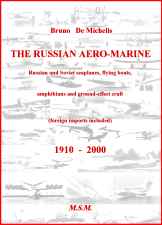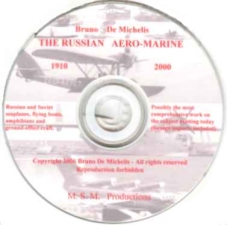
 |
from THE RUSSIAN AERO-MARINE by Bruno De Michelis |
|
selection from THE RUSSIAN AERO-MARINE by Bruno De Michelis Lieutenant F. Dorozhinskiy, an aviation expert, was sent to France by one of his superior officers, with the order to contact the Antoinette aircraft firm and to commission the construction of an aircraft. The Lieutenant advanced, on behalf of the Russian fleet's command, a sum of 12000 rubles to the above-mentioned firm to build a high-wing monoplane and send it to Russia. This deal, accepted by the manufacturer, included the training of two pilots for the specific machine, which Dorozhinskiy (and one of the Russian mechanics traveling with him) undertook in France. In June 1910 the aircraft arrived in Sevastopol and on September the 16th Dorozhinskiy demonstrated with competence the capabilities of the French plane above Kulikov airfield. Almost immediately, a proposal for transforming the Antoinette into a seaplane was made, such a craft being an ideal complement to the fleet. After the necessary modifications, the lieutenant tried time after time to take off from water but in vain: the floats, locally custom-built for the craft, kept submerging at the bow and impeded the monoplane from reaching adequate speed. After a while, the trials were suspended and the whole idea was abandoned. And so it was that F. Dorozhinskiy, accompanied by another officer, V.N. Kedrin, returned overseas to purchase two new flying boats: a Curtiss biplane and an Etrich monoplane. Unfortunately, both manufacturers did not want to know about the contractual clause regarding pilot training, so the contracts were not stipulated. The two officers did not wish to return to Russia without commissioning any aircraft, so they decided to go to Monaco (France), where the famous seaplane races were taking place. Having seen several machines, they were favorably impressed by the performance of the canard Voisin, one of the first seaplanes in the world." |
 |
|
This photograph shows Voisin collaborator and test pilot Maurice Colliex flying the seaplane version of Gabriel Voisin's famous 'canard' biplane. Collection of Jean-Pierre Lauwers Identification by Reg Winstone, 12-7-2004 |
|
"After signing a contract for purchasing two of these seaplanes, Dorozhinskiy remained on site to observe the aircrafts' construction
progress and to be trained to fly them, while Kedrin returned to Russia. As soon as the first biplane canard was completed, the
lieutenant started his training. He learnt quickly, may be too quickly: after a few successful flights he crashed on landing and was
seriously injured, remaining unable to send reports to Sevastopol for a long while. While the craft was repaired (at great extra expense)
and the Lieutenant's silence was becoming noticeable in Russia, where nobody new the reason for such delay, the matter was
aggravated by a leak of information about the contract to the French press, which obviously thrived on it. At the beginning of 1912 the Russian Fleet Command, dissatisfied with the whole situation, ordered the injured and disgraced Dorozhinskiy to return to his quarters in Russia, putting another officer, I.I. Stakhovskiy, in charge of the matter. At this stage, it seemed that the manufacturers were on the verge of possible bankruptcy; it was not really so. During March-April of the same year, both canard seaplanes were delivered to Sevastopol, together with a French instructor who managed to train several Russian pilots without further problems. In 1912-1913 both seaplanes were duly used by the fleet on the Black Sea, bearing tactical numbers "1" and "2". The two canard Voisin (called “Vuasena” by the Russians) had a triple-strut wing configuration, with four partitions. The box wing and twin-seater fuselage rested on four wide plywood floats, with flat bottom, convex top and pointy leading and trailing edges. Three of them supported the fuselage through shock absorbing devices, the fourth sustained the canard. They definitely were amazing craft for those years: maybe Burt Rutan would love to use a time-machine, go back in history and fly them!" |
 |
 |
|
Product Details - Book Hard cover: 324 pages Publisher: MSM PRODUCTIONS Price: $110 postpaid |
Product Details - CD Files: Adobe PDF and MS Word Publisher: MSM PRODUCTIONS Price: $50 postpaid |
|
|
|
Editor's Note: If you have any more information on this pioneer aviator, please contact me. E-mail to Ralph Cooper Back 

|